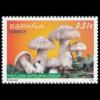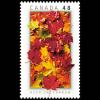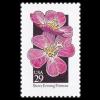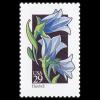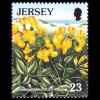Philately | Etymology |
|---|---|
Philately (fi-LAT-ə-lee) is the study of postage stamps and postal history. It also refers to the collection, appreciation and research activities on stamps and other philatelic products. Philately involves more than just stamp collecting or the study of postage; it is possible to be a philatelist without owning any stamps. For instance, the stamps being studied may be very rare or reside only in museums. The widespread use of email and online communication has impacted the volume of first class letters handled by the US postal system, from a high of 104 million letters/year in 2000, to 46 million letters/year in 2023. It's not difficult to see that the days of people sending letters with a postage stamp stuck on the envelope, via the postal system, a.k.a. "snail mail'" are in decline. On this site are displayed individual stamps, and sets of stamps, that I think are beautiful and/or noteworthy. Reference: usps.com | The word "philately" is the English transliteration of the French "philatélie", coined by Georges Herpin in 1864. Herpin stated that stamps had been collected and studied for the previous six or seven years and a better name was required for the new hobby than timbromanie (roughly "stamp quest"), which was disliked. (The French word for stamp is "timbre.") The alternative terms "timbromania", "timbrophily" and "timbrology" gradually fell out of use as philately gained acceptance during the 1860s. He took the Greek root word φιλ(ο)- phil(o)-, meaning "an attraction or affinity for something", and ἀτέλεια ateleia, meaning "exempt from duties and taxes" to form "philatelie". The next logical step was to take the word philatelie and combine it with the word taxon to arrive at "philatax" – the appreciation of stamps about taxon. Reference: Wikipedia |
The 5 most recently added stamps.
Click on the various links and explore how countries commemorate animal, plant and fungi species in our world.
Philately | Etymology |
|---|---|
Philately (fi-LAT-ə-lee) is the study of postage stamps and postal history. It also refers to the collection, appreciation and research activities on stamps and other philatelic products. Philately involves more than just stamp collecting or the study of postage; it is possible to be a philatelist without owning any stamps. For instance, the stamps being studied may be very rare or reside only in museums. The widespread use of email and online communication has impacted the volume of first class letters handled by the US postal system, from a high of 104 million letters/year in 2000, to 46 million letters/year in 2023. It's not difficult to see that the days of people sending letters with a postage stamp stuck on the envelope, via the postal system, a.k.a. "snail mail'" are in decline. On this site are displayed individual stamps, and sets of stamps, that I think are beautiful and/or noteworthy. Reference: usps.com | The word "philately" is the English transliteration of the French "philatélie", coined by Georges Herpin in 1864. Herpin stated that stamps had been collected and studied for the previous six or seven years and a better name was required for the new hobby than timbromanie (roughly "stamp quest"), which was disliked. (The French word for stamp is "timbre.") The alternative terms "timbromania", "timbrophily" and "timbrology" gradually fell out of use as philately gained acceptance during the 1860s. He took the Greek root word φιλ(ο)- phil(o)-, meaning "an attraction or affinity for something", and ἀτέλεια ateleia, meaning "exempt from duties and taxes" to form "philatelie". The next logical step was to take the word philatelie and combine it with the word taxon to arrive at "philatax" – the appreciation of stamps about taxon. Reference: Wikipedia |
The 5 most recently added stamps.
Click on the various links and explore how countries commemorate animal, plant and fungi species in our world.


